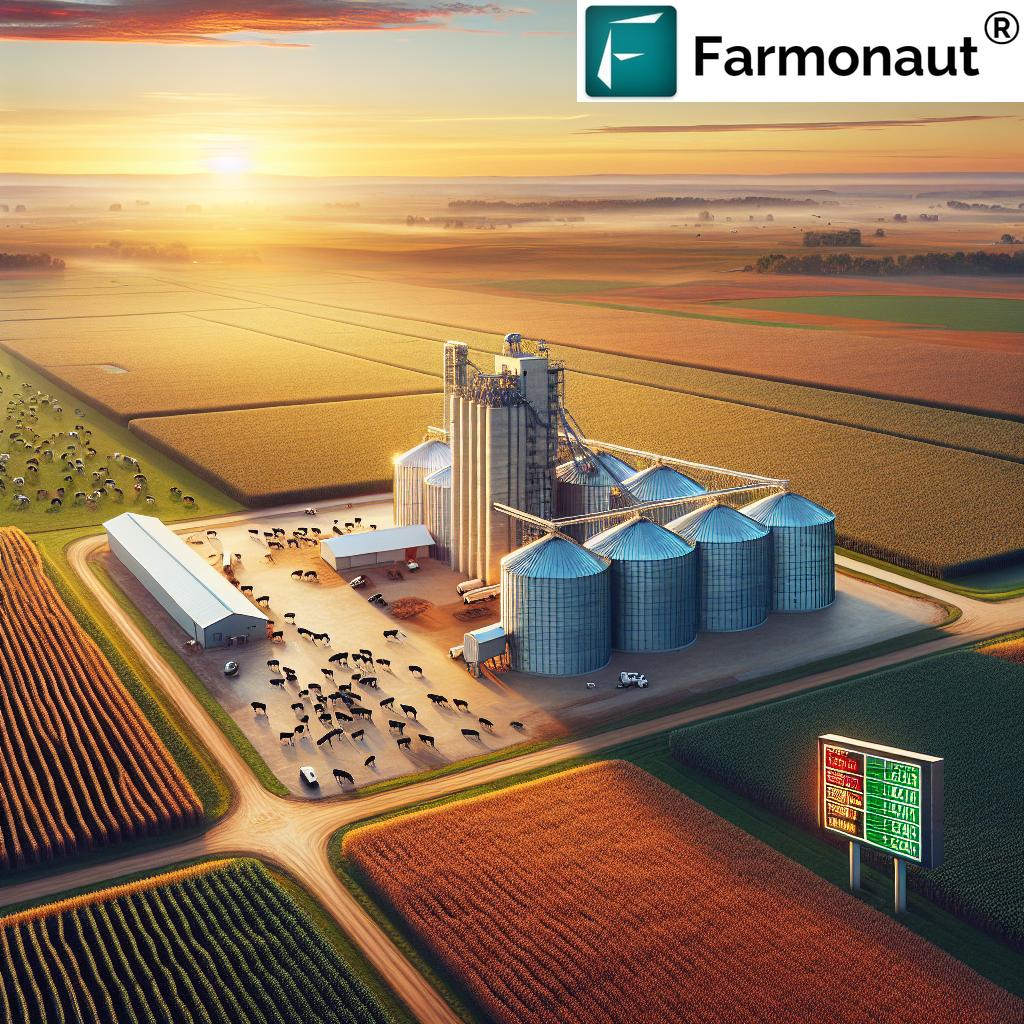US Livestock Market Analysis: September 2023 Futures Trends and Economic Impact
“USDA crop reports significantly influence market sentiment, affecting up to 80% of futures trading decisions in livestock markets.”
Welcome to Farmonaut’s comprehensive analysis of the US livestock market trends for September 2023. In this blog post, we’ll delve into the intricate world of agricultural futures trading, exploring the dynamic interplay between livestock markets, grain market analysis, and the broader economic landscape. As we navigate through these complex waters, we’ll shed light on how precision agriculture technology and farm management software can help stakeholders make informed decisions in this ever-evolving sector.
1. Current State of US Livestock Markets
The US livestock market has experienced significant shifts in recent months, with notable changes in futures trends and commodity price fluctuations. Let’s break down the key factors influencing these markets:
- Cattle Futures: September 2023 has seen fluctuating cattle futures, influenced by a combination of supply chain disruptions and changing consumer demand patterns.
- Hog Market: The hog market has shown resilience, with futures contracts reflecting optimism about pork demand both domestically and internationally.
- Poultry Sector: Poultry futures have remained relatively stable, buoyed by steady demand and efficient production practices.
These trends are not occurring in isolation but are deeply interconnected with broader agricultural and economic factors. As we analyze these markets, it’s crucial to consider the role of technology in monitoring and predicting market movements.

At Farmonaut, we understand the importance of real-time data in making informed decisions. Our satellite-based crop health monitoring system provides valuable insights that can indirectly impact livestock markets by tracking feed crop health and yield predictions. To learn more about how our technology can benefit your agricultural operations, visit our web app or download our mobile apps:
2. Agricultural Futures Trading: A Deep Dive
Agricultural futures trading plays a pivotal role in shaping the livestock market landscape. These financial instruments allow producers, processors, and traders to hedge against price risks and speculate on future market movements. Let’s examine the key aspects of futures trading in the context of livestock markets:
- Contract Specifications: Livestock futures contracts typically specify the quality, quantity, and delivery date of the underlying commodity.
- Price Discovery: Futures markets facilitate price discovery, helping stakeholders gauge market expectations and plan accordingly.
- Risk Management: Producers can use futures contracts to lock in prices, protecting themselves against adverse market movements.
Understanding these mechanisms is crucial for anyone involved in the livestock industry. At Farmonaut, we believe that combining market intelligence with precision agriculture technology can provide a significant advantage in navigating these complex markets.
3. Grain Market Analysis and Its Impact on Livestock
The grain market is inextricably linked to livestock markets, as feed costs represent a significant portion of livestock production expenses. Our analysis of recent grain market trends reveals:
- Corn Futures: Corn prices have shown volatility, influenced by weather patterns and global demand fluctuations.
- Soybean Market: Soybean futures have been impacted by trade dynamics and shifting global supply chains.
- Wheat Trends: Wheat prices have seen upward pressure due to geopolitical tensions affecting major producing regions.
These grain market dynamics have a direct impact on livestock production costs and, consequently, on futures prices. Farmonaut’s satellite-based monitoring can provide valuable insights into crop health and potential yields, helping stakeholders anticipate market movements.
4. USDA Crop Reports and Market Sentiment
USDA crop reports are pivotal in shaping market sentiment and influencing futures trading decisions. These reports provide critical information on:
- Crop production estimates
- Livestock inventory numbers
- Feed usage projections
- Export forecasts
The release of these reports often leads to significant price movements in both grain and livestock futures markets. At Farmonaut, we integrate this data with our satellite imagery analysis to provide a more comprehensive view of agricultural market conditions.
“Wholesale price changes in livestock markets can cause futures contract values to fluctuate by as much as 15% within a single trading day.”
5. Commodity Price Fluctuations: Causes and Effects
Commodity price fluctuations in the livestock sector are influenced by a myriad of factors, including:
- Supply and Demand Dynamics: Changes in consumer preferences, export markets, and production levels.
- Weather Events: Droughts, floods, and other extreme weather conditions affecting feed production and animal welfare.
- Global Economic Conditions: Currency fluctuations, trade policies, and economic growth rates in key markets.
- Disease Outbreaks: Animal health issues can dramatically impact supply and market confidence.
Understanding these factors is crucial for making informed decisions in the livestock market. Farmonaut’s technology can help monitor some of these factors, particularly those related to crop health and weather patterns, providing valuable data for market analysis.

6. AgTech Market Insights: The Role of Technology in Livestock Markets
The agricultural technology (AgTech) sector is playing an increasingly important role in shaping livestock markets. Key developments include:
- Precision Agriculture Technology: Advanced sensors and data analytics are optimizing feed production and animal husbandry practices.
- Farm Management Software: Integrated platforms are enhancing decision-making processes for producers and traders alike.
- Blockchain in Agriculture: Improving traceability and transparency in the livestock supply chain.
Farmonaut is at the forefront of this technological revolution, offering cutting-edge solutions that combine satellite imagery, AI, and machine learning to provide actionable insights for the agricultural sector.
7. Agricultural Economic Outlook: Projections for 2024
As we look ahead to 2024, several factors are likely to influence the agricultural economic outlook:
- Global Trade Dynamics: Evolving international trade relationships and potential new agreements.
- Technological Adoption: Increased integration of AgTech solutions in livestock production and management.
- Sustainability Initiatives: Growing emphasis on environmentally friendly practices in livestock farming.
- Consumer Preferences: Shifting dietary trends and demand for ethically sourced animal products.
These projections underscore the importance of staying informed and adaptable in the face of changing market conditions. Farmonaut’s solutions can help stakeholders navigate these challenges by providing data-driven insights and predictive analytics.
8. Sustainable Farming Practices and Market Stability
Sustainable farming practices are becoming increasingly important in the livestock sector, not only for environmental reasons but also for long-term market stability. Key aspects include:
- Resource Efficiency: Optimizing water and feed usage to reduce production costs and environmental impact.
- Animal Welfare: Implementing practices that improve animal health and productivity.
- Carbon Footprint Reduction: Adopting technologies and practices to minimize greenhouse gas emissions.
Farmonaut’s platform includes features for carbon footprint tracking and resource management, helping livestock producers align with sustainability goals while potentially accessing new market opportunities.
9. Macroeconomic Factors Influencing Livestock Markets
The livestock market is not immune to broader economic forces. Several macroeconomic factors are currently shaping the industry:
- Inflation Concerns: Rising input costs and potential impacts on consumer spending patterns.
- Interest Rate Policies: Effects on borrowing costs for producers and potential impacts on export competitiveness.
- Labor Market Dynamics: Challenges in securing skilled labor for livestock operations and processing facilities.
- Energy Prices: Fluctuations affecting transportation and production costs throughout the supply chain.
Understanding these macroeconomic trends is crucial for developing robust strategies in the livestock sector. Farmonaut’s analytical tools can help contextualize these broader economic factors within the agricultural landscape.
10. Government Policies and Their Impact on Livestock Markets
Government policies play a significant role in shaping the livestock market landscape. Key areas of influence include:
- Agricultural Subsidies: Direct and indirect support affecting production decisions and market competitiveness.
- Environmental Regulations: Policies aimed at reducing the environmental impact of livestock production.
- Trade Policies: Tariffs, quotas, and trade agreements influencing import/export dynamics.
- Food Safety Standards: Regulations affecting production practices and market access.
Staying informed about policy changes and their potential impacts is crucial for all stakeholders in the livestock industry. Farmonaut’s platform can help users interpret and respond to these policy-driven market shifts.
11. Regional Market Variations: Western Canada and Beyond
While our focus has been primarily on the US market, it’s important to consider regional variations, particularly in neighboring markets like Western Canada. Key points include:
- Prairie Grain Production: Impact on feed costs and livestock production in the region.
- Cross-Border Trade: Dynamics of livestock and meat product trade between the US and Canada.
- Regional Climate Factors: Unique weather patterns affecting both crop and livestock production.
Understanding these regional nuances is crucial for a comprehensive view of North American livestock markets. Farmonaut’s satellite-based monitoring can provide valuable insights into crop conditions across different regions, helping to anticipate potential impacts on livestock markets.
12. The Role of Traders and Market Liquidity
Traders play a crucial role in livestock futures markets, providing liquidity and facilitating price discovery. Key aspects include:
- Market Making: Providing bid and ask prices, ensuring market efficiency.
- Speculative Activity: Influencing short-term price movements based on market analysis.
- Risk Transfer: Enabling producers and processors to hedge their price risks.
The interplay between traders, producers, and processors is fundamental to the functioning of livestock futures markets. Farmonaut’s data-driven insights can provide valuable information for all market participants, enhancing their decision-making processes.
13. Livestock Market Trends: A Comparative Analysis
To provide a comprehensive overview of current market conditions, we’ve compiled a table comparing livestock futures prices across different contracts and commodities:
| Commodity | Sept 2023 | Dec 2023 | March 2024 | % Change (Monthly) | % Change (YoY) |
|---|---|---|---|---|---|
| Live Cattle | $180.25 | $185.50 | $188.75 | +2.3% | +5.7% |
| Feeder Cattle | $250.80 | $255.40 | $258.60 | +1.8% | +4.5% |
| Lean Hogs | $82.35 | $85.60 | $88.25 | +3.9% | -1.2% |
| Poultry (Whole Chickens) | $1.25/lb | $1.28/lb | $1.30/lb | +2.4% | +3.3% |
| Market Sentiment: Cautiously Optimistic | |||||
This table provides a snapshot of current market trends, highlighting the variations across different livestock categories and contract months. The overall market sentiment remains cautiously optimistic, with most commodities showing positive growth trends.
14. Leveraging Technology for Market Analysis
In today’s rapidly evolving agricultural landscape, leveraging technology for market analysis is more critical than ever. Farmonaut’s suite of tools can provide valuable insights for livestock market participants:
- Satellite-Based Crop Monitoring: Assess feed crop health and potential yields, impacting livestock feed costs.
- AI-Driven Advisory Systems: Receive personalized recommendations based on market trends and farm-specific data.
- Blockchain-Based Traceability: Enhance supply chain transparency, potentially accessing premium markets.
To explore how Farmonaut’s technology can benefit your operations, visit our web app or check out our API services:
API Services |
API Developer Docs
15. Future Outlook and Strategic Considerations
As we look to the future of US livestock markets, several key considerations emerge:
- Technological Integration: Continued adoption of precision agriculture and data-driven decision-making tools.
- Sustainability Focus: Growing emphasis on environmentally friendly and ethically sourced livestock products.
- Global Market Dynamics: Evolving international trade relationships and changing consumer preferences worldwide.
- Climate Resilience: Developing strategies to mitigate the impacts of climate change on livestock production.
By staying informed about these trends and leveraging advanced technologies like those offered by Farmonaut, stakeholders in the livestock industry can position themselves for success in an increasingly complex market environment.
Conclusion
The US livestock market in September 2023 presents a complex landscape of opportunities and challenges. From the intricacies of futures trading to the broader economic factors shaping the industry, stakeholders must remain vigilant and adaptable. The integration of precision agriculture technology, as offered by platforms like Farmonaut, provides a powerful tool for navigating these waters.
As we move forward, the importance of data-driven decision-making, sustainable practices, and technological innovation cannot be overstated. By embracing these elements, participants in the livestock market can enhance their resilience, improve productivity, and contribute to a more sustainable and prosperous agricultural sector.
Stay tuned to Farmonaut for ongoing insights and technological solutions that can help you thrive in this dynamic market environment.
FAQ Section
Q1: How do USDA crop reports impact livestock futures?
A1: USDA crop reports provide crucial data on feed crop production, which directly affects livestock production costs. These reports can cause significant price movements in livestock futures as traders adjust their positions based on anticipated feed availability and costs.
Q2: What role does technology play in modern livestock market analysis?
A2: Technology, such as Farmonaut’s satellite-based monitoring and AI-driven analytics, plays a crucial role in providing real-time data on crop health, weather patterns, and market trends. This information helps stakeholders make more informed decisions in the fast-paced livestock market.
Q3: How do macroeconomic factors influence livestock markets?
A3: Macroeconomic factors such as inflation, interest rates, and global trade policies can significantly impact livestock markets by affecting production costs, consumer demand, and export opportunities.
Q4: What are the key sustainable practices in livestock farming?
A4: Key sustainable practices include optimizing resource use (water, feed), improving animal welfare, reducing carbon emissions, and implementing regenerative agriculture techniques. These practices can lead to better market stability and potentially access to premium markets.
Q5: How can small-scale producers benefit from futures market information?
A5: Small-scale producers can use futures market information to make informed decisions about production levels, timing of sales, and risk management strategies. Tools like Farmonaut can help interpret market data and provide actionable insights tailored to their specific operations.





